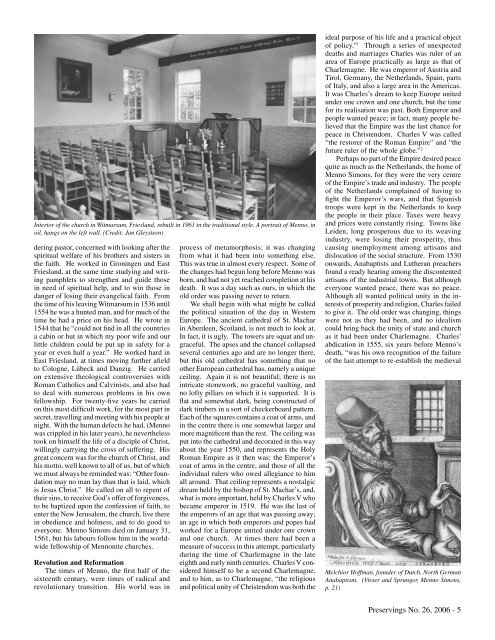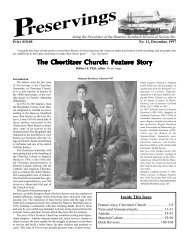Preservings $20 Issue No. 26, 2006 - Home at Plett Foundation
Preservings $20 Issue No. 26, 2006 - Home at Plett Foundation
Preservings $20 Issue No. 26, 2006 - Home at Plett Foundation
Create successful ePaper yourself
Turn your PDF publications into a flip-book with our unique Google optimized e-Paper software.
Interior of the church in Witmarsum, Friesland, rebuilt in 1961 in the traditional style. A portrait of Menno, in<br />
oil, hangs on the left wall. (Credit: Jan Gleysteen)<br />
dering pastor, concerned with looking after the<br />
spiritual welfare of his brothers and sisters in<br />
the faith. He worked in Groningen and East<br />
Friesland, <strong>at</strong> the same time studying and writing<br />
pamphlets to strengthen and guide those<br />
in need of spiritual help, and to win those in<br />
danger of losing their evangelical faith. From<br />
the time of his leaving Witmarsum in 1536 until<br />
1554 he was a hunted man, and for much of the<br />
time he had a price on his head. He wrote in<br />
1544 th<strong>at</strong> he “could not find in all the countries<br />
a cabin or hut in which my poor wife and our<br />
little children could be put up in safety for a<br />
year or even half a year.” He worked hard in<br />
East Friesland, <strong>at</strong> times moving further afield<br />
to Cologne, Lübeck and Danzig. He carried<br />
on extensive theological controversies with<br />
Roman C<strong>at</strong>holics and Calvinists, and also had<br />
to deal with numerous problems in his own<br />
fellowship. For twenty-five years he carried<br />
on this most difficult work, for the most part in<br />
secret, travelling and meeting with his people <strong>at</strong><br />
night. With the human defects he had, (Menno<br />
was crippled in his l<strong>at</strong>er years), he nevertheless<br />
took on himself the life of a disciple of Christ,<br />
willingly carrying the cross of suffering. His<br />
gre<strong>at</strong> concern was for the church of Christ, and<br />
his motto, well known to all of us, but of which<br />
we must always be reminded was: “Other found<strong>at</strong>ion<br />
may no man lay than th<strong>at</strong> is laid, which<br />
is Jesus Christ.” He called on all to repent of<br />
their sins, to receive God’s offer of forgiveness,<br />
to be baptized upon the confession of faith, to<br />
enter the New Jerusalem, the church, live there<br />
in obedience and holiness, and to do good to<br />
everyone. Menno Simons died on January 31,<br />
1561, but his labours follow him in the worldwide<br />
fellowship of Mennonite churches.<br />
Revolution and Reform<strong>at</strong>ion<br />
The times of Menno, the first half of the<br />
sixteenth century, were times of radical and<br />
revolutionary transition. His world was in<br />
process of metamorphosis; it was changing<br />
from wh<strong>at</strong> it had been into something else.<br />
This was true in almost every respect. Some of<br />
the changes had begun long before Menno was<br />
born, and had not yet reached completion <strong>at</strong> his<br />
de<strong>at</strong>h. It was a day such as ours, in which the<br />
old order was passing never to return.<br />
We shall begin with wh<strong>at</strong> might be called<br />
the political situ<strong>at</strong>ion of the day in Western<br />
Europe. The ancient c<strong>at</strong>hedral of St. Machar<br />
in Aberdeen, Scotland, is not much to look <strong>at</strong>.<br />
In fact, it is ugly. The towers are squ<strong>at</strong> and ungraceful.<br />
The apses and the chancel collapsed<br />
several centuries ago and are no longer there,<br />
but this old c<strong>at</strong>hedral has something th<strong>at</strong> no<br />
other European c<strong>at</strong>hedral has, namely a unique<br />
ceiling. Again it is not beautiful; there is no<br />
intric<strong>at</strong>e stonework, no graceful vaulting, and<br />
no lofty pillars on which it is supported. It is<br />
fl<strong>at</strong> and somewh<strong>at</strong> dark, being constructed of<br />
dark timbers in a sort of checkerboard p<strong>at</strong>tern.<br />
Each of the squares contains a co<strong>at</strong> of arms, and<br />
in the centre there is one somewh<strong>at</strong> larger and<br />
more magnificent than the rest. The ceiling was<br />
put into the c<strong>at</strong>hedral and decor<strong>at</strong>ed in this way<br />
about the year 1550, and represents the Holy<br />
Roman Empire as it then was: the Emperor’s<br />
co<strong>at</strong> of arms in the centre, and those of all the<br />
individual rulers who owed allegiance to him<br />
all around. Th<strong>at</strong> ceiling represents a nostalgic<br />
dream held by the bishop of St. Machar’s, and,<br />
wh<strong>at</strong> is more important, held by Charles V who<br />
became emperor in 1519. He was the last of<br />
the emperors of an age th<strong>at</strong> was passing away;<br />
an age in which both emperors and popes had<br />
worked for a Europe united under one crown<br />
and one church. At times there had been a<br />
measure of success in this <strong>at</strong>tempt, particularly<br />
during the time of Charlemagne in the l<strong>at</strong>e<br />
eighth and early ninth centuries. Charles V considered<br />
himself to be a second Charlemagne,<br />
and to him, as to Charlemagne, “the religious<br />
and political unity of Christendom was both the<br />
ideal purpose of his life and a practical object<br />
of policy.” 1 Through a series of unexpected<br />
de<strong>at</strong>hs and marriages Charles was ruler of an<br />
area of Europe practically as large as th<strong>at</strong> of<br />
Charlemagne. He was emperor of Austria and<br />
Tirol, Germany, the Netherlands, Spain, parts<br />
of Italy, and also a large area in the Americas.<br />
It was Charles’s dream to keep Europe united<br />
under one crown and one church, but the time<br />
for its realis<strong>at</strong>ion was past. Both Emperor and<br />
people wanted peace; in fact, many people believed<br />
th<strong>at</strong> the Empire was the last chance for<br />
peace in Christendom. Charles V was called<br />
“the restorer of the Roman Empire” and “the<br />
future ruler of the whole globe.” 2<br />
Perhaps no part of the Empire desired peace<br />
quite as much as the Netherlands, the home of<br />
Menno Simons, for they were the very centre<br />
of the Empire’s trade and industry. The people<br />
of the Netherlands complained of having to<br />
fight the Emperor’s wars, and th<strong>at</strong> Spanish<br />
troops were kept in the Netherlands to keep<br />
the people in their place. Taxes were heavy<br />
and prices were constantly rising. Towns like<br />
Leiden, long prosperous due to its weaving<br />
industry, were losing their prosperity, thus<br />
causing unemployment among artisans and<br />
disloc<strong>at</strong>ion of the social structure. From 1530<br />
onwards, Anabaptists and Lutheran preachers<br />
found a ready hearing among the discontented<br />
artisans of the industrial towns. But although<br />
everyone wanted peace, there was no peace.<br />
Although all wanted political unity in the interests<br />
of prosperity and religion, Charles failed<br />
to give it. The old order was changing, things<br />
were not as they had been, and no idealism<br />
could bring back the unity of st<strong>at</strong>e and church<br />
as it had been under Charlemagne. Charles’<br />
abdic<strong>at</strong>ion in 1555, six years before Menno’s<br />
de<strong>at</strong>h, “was his own recognition of the failure<br />
of the last <strong>at</strong>tempt to re-establish the medieval<br />
Melchior Hoffman, founder of Dutch, <strong>No</strong>rth German<br />
Anabaptism. (Visser and Sprunger, Menno Simons,<br />
p. 21)<br />
<strong>Preservings</strong> <strong>No</strong>. <strong>26</strong>, <strong>2006</strong> -
















